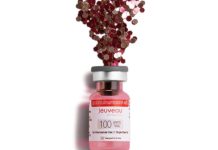We chat to Dr Victoria Manning and Dr Charlotte Woodward, co-owners of River Aesthetics, about the rising popularity of thread lifts for male patients.
Interest and demand for male treatments are on the rise. A 2019 report by the British Association of Aesthetic Plastic Surgeons found that men want to tweak their look, rather than look entirely tucked. As a result, thread lifts are becoming a popular choice for male patients as they can target a wealth of areas using natural stimulation, resulting in facial rejuvenation and enhancement.
Threads effectively treat the signs of ageing and give a naturally refreshed appearance from the dual lifting and regenerating collagen effect, helping to achieve defined and chiselled features. River Aesthetics was one of the earliest adopters of thread lifts and has become known as one of the UK’s leading clinics for the treatment. Owners Dr Victoria Manning and Dr Charlotte Woodward have seen a rise in demand for male enhancements, with around 10% of their patients male, a number that’s growing year on year. One of the biggest trends they have noticed is heterosexual men whose wives are having treatments following suit, with men aged 40 to 55 actively requesting thread lift treatments.
Dr Manning says, “We have really noticed a lot more men coming in because of their partners. We’re getting a lot of young guys looking for treatments like tear troughs, chins and jawlines, and then for threads, it is more the 40s age bracket and upwards.”
WHY THREADS?
Dr Manning and Dr Woodward have been using threads for eight years and have worked mainly with global aesthetic company Sinclair Pharma throughout that time. “We were one of the early adopters of threads”, says Dr Manning. “We love threads because we can get reproducible, natural results. Lots of our clientele, particularly men, don’t want a pushed-up look, which you don’t get with threads.”
Dr Woodward adds: “We always say, ‘if you look done, we’ve failed’. If you can pull everything back and take 10 years off somebody, but do it without them looking like they’ve had anything done, you’ve done your job. You can do that with threads, combined with other collagen-stimulating treatments.”
Patient selection is paramount for threads, whether treating male or female patients, as is making sure you are not mismanaging expectations. Drs Woodward and Manning use the Sinclair Pharma skin laxity protocol to help identify suitability for treatment. “It’s a really good tool that helps us show patients which grade they’re on during the initial consultation, whether they have mild, moderate, or severe laxity and which treatment protocol we’re going to go down”, says Dr Manning.
For male patients, the desired look is often a chiselled jawline and strong chin. Threads are particularly useful in this instance as they can enhance facial definition by addressing sagging skin to treat jowls, marionette lines, nasolabial folds and facial asymmetry in the male patient. “With threads, it is very easy to maintain the male appearance rather than feminsing the face,” says Dr Manning. “If you get fillers wrong, it’s very easy to give male patients a more ‘apple cheek’ effect; they instantly look more feminine, whereas with threads, it’s easier to maintain their masculinity. You can really structure the jawline with threads, too, giving them an angled look. That’s why we use them.”
ANATOMICAL CONSIDERATIONS
While motivations for seeking treatment may be the same across genders, male patients require different treatment protocols, and differences in anatomy must be taken into account if you want to restore the correct desirable features. When treating any patient with threads, it is important to consider the five layers:
• Skin
• Superficial fat
• Superficial muscular aponeurotic system (SMAS)
• Deep fat
• Bone
Male skin is as much as 25% thicker than female skin due to androgen stimulation. Men also have a tougher skin texture, a deeper dermis and a greater volume of subcutaneous fibrous tissue. Their faces are also biologically larger than female faces. All of this impacts how many threads need to be used and the depth of the thread placement (typically 8mm in male patients to reach the subcutaneous layer as opposed to 5mm in females). The ageing of the male face is also different and tends to follow a pattern. Firstly, there is atrophy of the deep and superficial fat, followed by dehiscence of the mandibular septum, resulting in the ptosis of both fat compartments. Finally, there is a gradual loss of definition of the jawline as the bone is resorbed. This typically starts around the age of 35 and leads to a more obtuse mandibular angle, chin retraction and the more pronounced appearance of the pre-jowl sulcus.
“Men tend to get that kind of umbrella deformity – they lose the buccal fat and can start looking hollow and gaunt,” says Dr Manning. “Quite often, when that happens, you have to address the volume loss as well as the tissue repositioning. Male skin is interesting because it’s much thicker; it’s more fibrous and there’s more subcutaneous tissue, so it’s actually easier to put threads in male skin.
Dr Woodward adds,“Womens’ skin changes enormously at menopause, where collagen is lost very suddenly. Men don’t suffer from that. Their skin’s thicker and tougher and tends to be more weathered. A lot of men have very sun-damaged skin, too. When they smile, they get lines. Threads are very good for that as they replace collagen and texture in the skin.”
THE TREATMENT
Smooth sutures are inserted via needle beneath the subcutaneous layer of fat in the face and pulled tight to instantly lift sagging skin. Once the threads are in place, the body produces new bundles of collagen around each thread, which gradually plumps out the skin, resulting in an incredibly rejuvenating effect.
Drs Manning and Woodward advise making sure you consider the extra weight of the tissues when treating male faces as this will have an impact. “You need to consider the forces that individual threads will be placed under and ensure that the weight is correctly distributed”, says Dr Manning. “Male patients typically benefit from more threads per treatment than females.” In addition to the initial lifting results from the treatment, the threads trigger the body’s natural healing response by stimulating collagen regeneration and encouraging continued volume and tightness long after the thread dissolves. As a result, the face is redefined, and the effects of ageing are significantly reduced. These results can last up to two years.
Male treatments sometimes don’t last as long, which can often be down to lifestyle factors. Dr Woodward says, “It’s similar to administering Botox on men, which tends not to last as long as on women because their muscles are stronger.
“With threads, they don’t tend to last as long as their tissues are heavier. Lifestyle factors also come into play. Most of the guys we treat are sporty and running a lot, which can reduce the longevity of the treatment. “We encourage male clients to wear SPF every day, to drink plenty of water, eat healthily and not drink too much alcohol. We recommend Skinade’s collagen drink and if they are smokers, we encourage them to give up.”
Getting the best results also comes down to patient selection. Dr Manning says, “Patient selection has to be at the forefront. Make sure the skin isn’t too saggy and is in good condition and that their skincare regime and skin integrity is also good. It’s a bit like being an artist: you need a good canvas to begin with to achieve optimum results. A holistic approach will always ensure the best results long term.”






